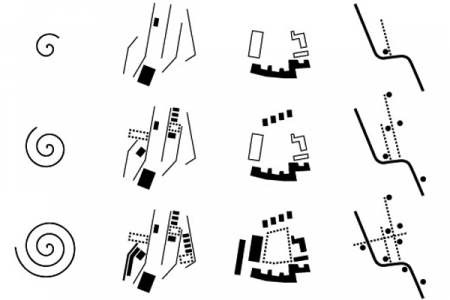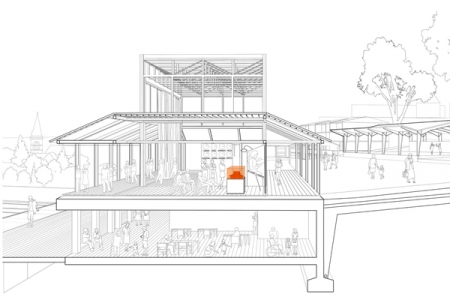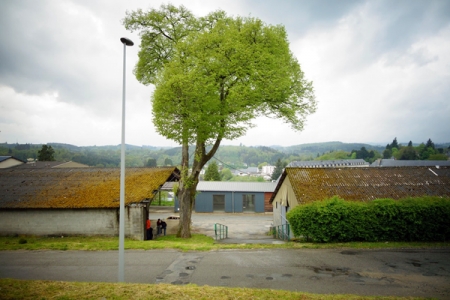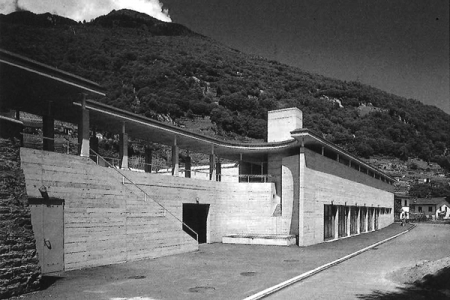Clubhouses
La Corrèze (FR) – Winner
TEAM DATA
Team Representative: Alexandre Dubure (FR) – architect urbanist; Associates: Thomas Nouailler (FR), Jenny Reuillard (FR) – architects
2 rue du Charolais, 75012 Paris – France
alexandre.dubure@gmail.com
See the complete listing of portraits here
See the site page here

A. Dubure, J. Reuillard & T. Nouailler
INTERVIEW
Click on the images to enlarge
1. How did you form the team for the competition?
We are originally from France’s Massif central –an elevated region in South-Central France, consisting of mountains and plateaux–, and rurality has therefore always been at the heart of our daily life. We also studied it, along with the metropolis, at the ENSA Clermont-Ferrand, where we graduated. Now that we are architects project managers at Obras in Paris, Europan is for us the occasion to consider rural territories together again, with our shared and individual experiences.
2. How do you define the main issue of your project, and how did you answer on this session main topic: Adaptability through Self-Organization, Sharing and/or Project (Process)?
In rural territories, in the region of La Corrèze particularly, adaptability is a necessity. As the municipalities have limited resources, the projects are implemented through successive small actions. Sometimes, the municipality only implements one building or one piece of public space during a whole electoral mandate. On the other hand, private actions –housing, shops and health facilities– are not very well controlled, although they play an important structuring role on the territory. The issue is that those small impulsions lead towards one shared vision that can last over time. This led us to consider an open process-project with a constant feedback between the objective and the means to get to it. Instead of a site plan, project "figures" are a means to initiate those feedbacks. The three sites allow imagining an open structure each time, which can be patiently implemented and can evolve according to the needs, the funds and land availability, without people ever feeling it as not completed.
3. How did this issue and the questions raised by the site mutation meet?
On each site, we made one simple structure emerge, each time unique –the terraces in Ussel, the four-sided island in Argentat, the geography and parcels orientation in Turenne– and fixing a general character and a certain number of invariants –orientations, scale relations, insertion according to topography– while allowing many variations and adaptations. We thought of it as necessary, while working on shared action principles, to manage to find those simple components on each site. For example, the four-sided island in Argentat became a “backyard", a place of proximity for the inhabitants who could invest it naturally, maintain it through interventions on the public space and create links. We realised that this physical situation at the heart of the block was actually very dependent on the context in Argentat.
4. Have you treated this issue previously? What were the reference projects that inspired yours?
We are actually confronted to this issue almost all the time. Our generation has more or less known only this type of situation, with limited resources. And we are now used to working on long-term urban planning projects, where we have to find ways to activate the transformation and keep it alive, including when the actors are changing and the projects mechanically exhaust after the first implementations. Besides, our generation grew up with slightly different working methods, with unexpected encounters between actors who sometimes come from very different cultural backgrounds and then have to work together. We thought a lot of Luigi Snozzi and the restructuration project of the Monte Carasso village in Switzerland, in which every simple intervention multiplies the effects. Another reference for us was the Hooké collective – a fly-fishing collective from Canada which developed different activities around one common passion – graphic design, video, fishing material, sportswear, expeditions… This kind of initiative –gathering people in one place and around one shared interest– inspired us the name "Clubhouses" for the project.
5. Today –at the era of economic crisis and sustainability– the urban-architectural project should reconsider its production method in time; how did you integrate this issue in your project?
We like to quote Pierre Boulez, who inspired us to figure of the spiral which, whatever its development, keeps the same shape. The important thing is that there is a beginning and an end, a starting point and an arrival, which allow breaking it and still knowing where we are at. And taking it back a bit later. A specific project culture should be developed for those territories, concerning of course the building method, but also the method itself. We believe we should work here on working methods which might take longer time, and even be smaller, and yet would be more sustainable. This project culture should also gather actors who should not meet at first. So each project cannot be considered on its own, it has to be part of a larger discussion and to multiply the contact surfaces with the actors. We believe in La Corrèze’s ability to be attractive, not only as a touristic place but also as a place to live. It is not a question of "long" term. We could –today– begin to develop an important intensity. People are waiting for it.
6. Is it the first time you have been awarded a prize at Europan? How could this help you in your professional career?
Each of us already been rewarded separately after previous sessions of the competition – A. Dubure, E11 runner-up in Porvoo (FI); T. Nouailler, E9 winner in Andenne (BE) and E12 winner in Paris-Saclay (FR); J. Reuillard, E11 runner-up in Clermont-Ferrand (FR)).
Europan is a thrilling framework to think about substantial issues, meet and exchange with of professionals, and feed the reflections we started on other projects (whether at work or while researching…). This competition was for us the occasion to test our complementarity in a team, although we already knew at first that we were sharing close views on the project. There is some kind of autonomy when considering such a context, but most of all an opportunity to directly bring our project in front of the site actors, technicians and elected representatives, and even to a larger debate with the reflection launched by Europan. We know how difficult it is to professionally implement a Europan winning project, but for us, it was important to be able, today, to continue the discussion on the project, accompany the actors and stimulate them in their wish to work on their territories.







